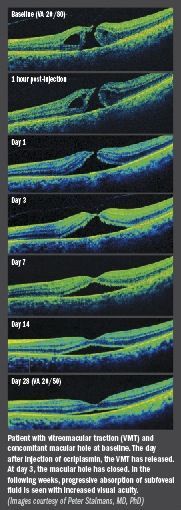Article
Appropriate case selection maximizes success with ocriplasmin
Results from the MIVI-TRUST trials serve as a guide to identifying cases of symptomatic vitreomacular adhesion that are most likely to achieve success with ocriplasmin treatment.
Take-home
Results from the MIVI-TRUST trials serve as a guide to identifying cases of symptomatic vitreomacular adhesion that are most likely to achieve success with ocriplasmin treatment.

Dr. Stalmans
By Cheryl Guttman Krader; Reviewed by Peter Stalmans, MD, PhD
Leuven, Belgium-Findings from the phase III clinical trials investigating ocriplasmin (Jetrea, ThromboGenics) for the treatment of symptomatic vitreomacular adhesion-vitreomacular traction (VMT) with or without macular hole-together with understanding of the natural history of the condition provides guidance for optimizing patient outcomes in clinical practice, according to Peter Stalmans, MD, PhD.
“My recommendation is to treat immediately after the diagnosis is made, especially in VMT patients with a macular hole,” said Dr. Stalmans, Department of Ophthalmology, University Hospitals Leuven, Belgium.
Choosing cases for success
Results of the pivotal Microplasmin for IntraVitreous Injection-Traction Release without Surgical Treatment (MIVI-TRUST) trials showed that size of the vitreomacular traction insertion, macular hole aperture, and presence of an epiretinal membrane (ERM) were factors for predicting outcome. Since patients in Belgium currently must pay out-of-pocket for ocriplasmin treatment, Dr. Stalmans said he uses this information as a guide to identifying cases that are most likely to achieve success.
His criteria are contact area between the posterior hyaloid and retina <1,500 µm, macular hole aperture ≤250 µm, and absence of a concomitant ERM.

“My commercial experience with ocriplasmin injection between the end of June 2013 and January 2014 includes 35 eyes,” Dr. Stalmans said.
Using these parameters for case selection, VMT release was achieved in 75% eyes with VMT only and in 80% of VMT with macular hole, with subsequent macular hole closure in 55%. In MIVI-TRUST, where about 37% of eyes had a concomitant epiretinal membrane, the VMT release rate was just 26%, he noted.
Scheduling secondary surgery
In the MIVI-TRUST trials, the first follow-up optical coherence tomography (OCT) was performed at 1 week post-injection and was done using time-domain technology.
In clinical practice, Dr. Stalmans has been obtaining spectral-domain OCT images and at earlier intervals.
With the additional information from the more intensive follow-up and higher resolution images, he has determined that 80% of eyes show a treatment benefit within 24 to 48 hours after injection. In most others, the treatment effect may not be seen for 1 to 2 weeks.
However, based on MIVI-TRUST, it is clear that if ocriplasmin is effective, the benefit will be seen within 4 weeks.
Knowing this time course of response and that time is of the essence for optimizing visual recovery in patients with a macular hole, Dr. Stalmans said that he simultaneously offers these patients ocriplasmin and recommends scheduling a date for surgery in 6 to 8 weeks.
“We explain to the patient that we will wait up to 1 month to determine if there is benefit from the ocriplasmin,” he said. “If the ocriplasmin does not work, there is not a significant delay before proceeding with surgery.
“And when it does, being able to cancel the surgery is a real psychological victory for the patient,” he added.
Though there is less concern about the timeliness of surgery in eyes with VMT and no macular hole, Dr. Stalmans noted he might also set up a tentative future date at the time of diagnosis for patients with severe metamorphopsia.
Counseling and follow-up
Informing patients about possible adverse events is important when treating with ocriplasmin. About 50% of patients develop floaters and flashers in the first 24 to 48 hours post-injection-a phenomenon that is often described as the type of snow seen on a television screen when there is no cable reception.
In addition, about 5% to 10% of patients experience an early, temporary decrease in visual acuity. The latter event is nearly always associated with the presence of subretinal fluid and is a positive prognostic sign, Dr. Stalmans said.
“In patients [treated with ocriplasmin], there is about a 90% correlation between the occurrence of subretinal fluid and hyaloid detachment,” he said. “Frequently, first the fluid appears and the treatment benefit occurs days to weeks later.”
Since the visual side effects are most likely to occur in the first several few after treatment and aiming to facilitate patient access for follow-up care, Dr. Stalmans said he always schedules his ocriplasmin injection cases in the beginning of the week.
“I recommend to call patients on the first day after the procedure to find out how they are doing and to reassure them if they are experiencing any symptoms,” he said. “If anyone is particularly worried and would like to be seen, it is much easier for them to be seen by a retinal specialist on a weekday than on the weekend.”
Peter Stalmans, MD, PhD
Dr. Stalmans’ university institution receives lecture fees and grant support from ThromboGenics.
Subscribe to Ophthalmology Times to receive the latest clinical news and updates for ophthalmologists.
Illustration caption:
Patient with vitreomacular traction (VMT) and concomitant macular hole at baseline. The day after injection of ocriplasmin, the VMT has released. At day 3, the macular hole has closed, in the following weeks progressive absorption of subfoveal fluid is seen with increased visual acuity. (Image courtesy of Peter Stalmans, MD, PhD)
Newsletter
Don’t miss out—get Ophthalmology Times updates on the latest clinical advancements and expert interviews, straight to your inbox.




